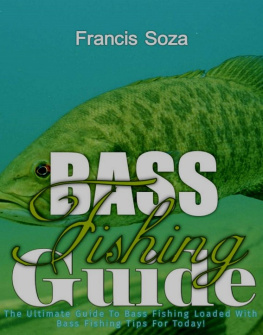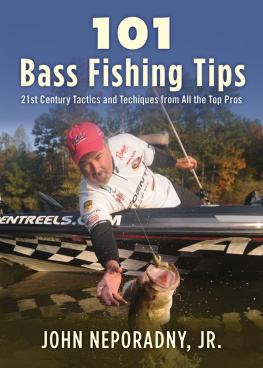BASS FISHING WITH A FLY
The Complete Guide on How to Catch a Bass on a Fly Rod (Including the Top 10 Flies that will land you the Monster Bass)
Tim Robert
Copyright@2018
TABLE OF CONTENT
CHAPTER 1
BASS FISHING
Bass is one of the most enjoyable sport fishing to target with any type of method
For die hard bass anglers, fly fishing is one of the most fun loving new ways to get their favorite fishes, for fly angler, bass are abundantly available and challenging fish that are guaranteed to give a new challenge

Irrespective of where you live, there is a very high chance that there is a pond, lake or river nearby that holds the bass that will willingly take a fly and give you a wonderful fight
PREPARING FOR A FIGHT
Bass are well known for their wonderful fighting abilities on any challenge when you are after them, it is important to be prepared with the correct equipment not only to catch them but to get the right flies in the place where they live

Bass are ambush predators and will mostly look for the heaviest cover where they can hide and wait for unwary preys to swim into
Bass anglers are mostly faced with challenges of casting their fly directly into a weedy region and wrestling a hooked bass out of the water so heavy than the normal will require a challenge
For a large bass or when you are fishing around snags and weeds, a 9-foot, 8-weight fly rod and matching reel with a strong drag is a good option
An 8-weight fly rod and matching reel with a powerful drag is a very good option

An 8-weight is also a very wonderful choice for casting large bass flies that would be heavy and difficult to cast on lighter rods, for smaller bass, small bass, smaller flies, and open water, a 9-foot 6-weight rod is a better alternative
CHAPTER 2
DIFFERENT TYPES OF FISHING LINES ACCORDING TO DEPTH
Bass can be found in any part of the water column, from just below the surface to the right on the bottom
Many anglers use only a floating line and choose a target bass when they are in shallow water, but to be prepared for any situation having some different lines placed on extra reels or spare spools is a good idea
FLOATING LINE
A weight-forward floating line with a heavy front taper is the easiest of fly fishing for bass and will work very well in shallow water situations
Bass are a shallow water predator and can often be found holding or feeding in water that is less than six feet deep
Floating lines are the best choice for any water surface and work very well when joined to a longer leader and sinking fly for getting below the surface
INTERMEDIATE AND SINK TIP LINES
When you need a sustained subsurface or you think that the fish are holding and feeding in water between 6-10 feet deep
It is advisable to go for a slow sinking or sink tip fly line
Intermediate fly lines are clear in color and sink at a slow rate of about 1 to 2 inches per seconds so that they are very good for pulling a fly over the top of a shallow weed bed or fishing at a gradual drop off
A sink tip fly usually has a floating head tipped with a short portion of fast sinking line at the extreme end and is very good for reaching the bottom very easily and moving the fly through drop-offs, snags and other underwater structures in shallow to moderately depth water
FAST SINKING FLY LINES
There are some instance when the bass go down and the only way you can catch them is to fish a fly over deep structure or crawl it into the base
A fly line with a sink rate of 6-10 inches per seconds is the best line to use for these
You can make a long cast and count down to the required depth before you start to remove
LEADERS
The choice of leader to use will depend on the line you are using, the size of your fly and how much cover is available if you are fishing
It is good to use a 7.5 foot tapered leader with a breaking strength 12 to 15 pounds is sufficient
For a sinking and sink tip lines, for small flies or clear water with little snags, you can reduce it up to 6-8 pounds, In very heavy snags or for fishing very big flies, you may want for up to 20 pounds
CHAPTER 3
WHAT TO FEED BASS
Bass usually feed from a variety of aquatic and terrestrial creatures and choose food according to how it is available

In traditional fly fishing, bass anglers usually use flies that dives, wiggle and dart naturally to make the fish into striking
A good variety of floating bugs, and unweighted streamers and weighted jigging flies will allow you to fish for bass from the surface to the bottom
Poppers, divers, sliders and gurglers and other flies that make a disturbance on the surface are a joy to them
Poppers are created with a cupped face to make a big disturbance when deepen
Divers usually float on the surface and will dive below with a pull of line
Sliders and gurglers are usually made to ride near the surface when creating a slight disturbance which can be deadly for bass that will run away from the very aggressive action of poopers and divers
In general big, noisy poppers and divers are good for low light or when there is some wind in the water, while smaller bugs, slides and gurglers are very effective for calm and brighter skies
When fishing floating bugs, it is good to read the water and the target cover or structure where you think you might find the fish
Start by casting the fly close to the target and let it settle before you start to remove, and it is advisable to wait for a few seconds before you remove
If nothing takes the fly in the beginning, pause and start to remove
Next point the tip of the rod directly at the fly and hold it at the same level with the water so it does not slack
It is advisable to keep your fly close to strike zone for a long timer
Streamers and slow sinking flies are great for fishing in the middle of the water column
CHAPTER 4
WHERE TO FIND BASS
Finding the bass in water requires the ability to recognize the different types of cover and structure where they would like to rest and feed
Underwater or above water cover such as weeds, docks, debris and even shades can lure bass
Structures such as rock, drop offs, channels and points are also very important in bass mostly if any of the former mentioned types of cover are available
WEEDS
Weeds are available in different types but important thing is that if you see the weed you will find the bass

Start by looking at the edge where the weeds drop off into the deeper water meet the shoreline and fish top water
Start by casting a floating bug into pockets, holes in the weed bed and turn it around the openings
If the weeds form a mat on the surface, you should try crawling a fly with a goat weed guard over the top and on hot days bass will hold in the shade below the weeds and move straight through the canopy to attack your fly
Next page












